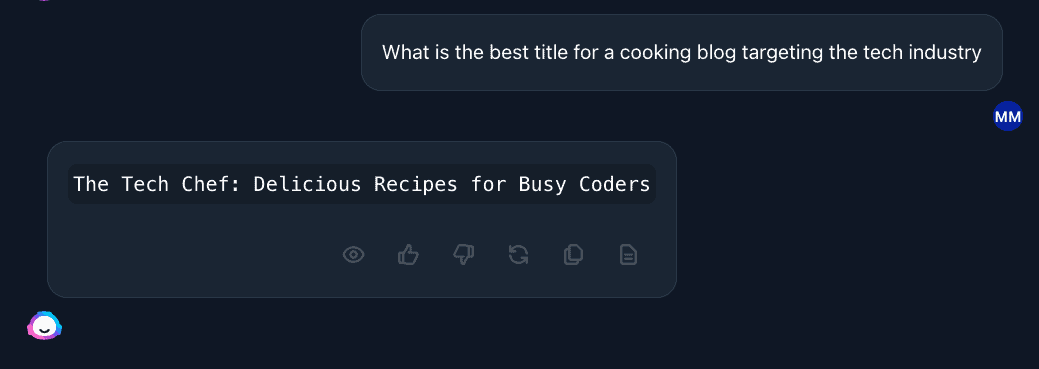5 Ways To Write Alongside Generative AI
Are AI writing tools such as Chat GPT and Jasper AI ready to replace human writers, artists, or software developers? Generative AI, as it’s better known, made headlines in late 2022 and across social media outlets for its ability to craft well-written copy and content. But something to keep in mind is that Chat GPT isn’t just churning out quality content by itself. This AI software is a tool that relies on a human to guide it and enable its core functionalities. This article will walk you through five basic strategies to keep in mind when writing alongside generative AI.
Who should be concerned about the rise of generative AI writing software?
The broad answer to this question seems to be everyone and no one – yet. There have been concerns raised about generative AI’s ability to write basic code and how AI software could impact artists. On that front, we could look to the past for insight. Photography didn’t replace painting, it opened the door to widespread access to the art world and new forms of artistic expression.
Generative AI in the workplace and schools
While there have been some concerns over the long-term job security of professional writers facing an AI threat, there’s also enough evidence that this likely won’t be the case for quite some time. Some argue that the real danger posed by OpenAI’s software is not to professionals in the workplace, but search engines and schools hoping to combat plagiarism.
The most likely scenario is that there won’t be “an AI” that replaces writers, but rather a human using AI. There will still need to be someone in charge of the interface knowing exactly what prompts to use and how to craft the AI’s work into something usable. That person is most likely to be….wait for it… a writer! Or at least an editor.
After all, AI is great at simulating good work, but it doesn’t always hold up under the microscope. AI might not give you great writing every time, but a strong editor can turn any output into great content. That’s the key when looking at what an AI can do with writing prompts.
What should I consider before writing with the help of generative AI?
When you want to collaborate with an AI writing tool, you should go in with a plan. Specifically, there are five tips you should keep in mind when writing with AI. The source for those tips? You guessed it! None other than (one of) the AI’s of the hour Jasper AI. We asked Jasper what it thought were the five most important strategies writers should keep in mind when collaborating with an AI and here’s what it came up with:
OK, so that’s all well and good, but is that practical advice? According to the experts, AI writing software — or generative AI — struggles with context and frames of reference. That means it can’t use a search engine to find answers the way that you might. So when you see a list like the one above, take it with a grain of salt and interpret it as you will. In this case? We interpreted quite a bit.
Tip #1: Have a clear vision for your AI-driven project
This means understanding what it is you’re trying to write and how you plan on getting there. When writing with AI, make sure you map out your content in advance. Additionally, give the AI as much information as possible so you get the best possible content.
While you can ask generative AI to write your content for you, it will be up to you to decide how useful that content is and whether or not it suits your audience’s needs. Paid plans for services such as Jasper offer templates, structured documents, and other extensions of the service. Free chat services, meanwhile, can give writers a framework, but it’s up to the writer to then hone those words into something usable.
AI as a lead writer, editor, or assistant?
In our experience, even that premium AI-generated content requires a significant amount of editing in order for it to be useful to an audience. Depending on the category and themes you’re writing about, generative AI may struggle with producing a perfect document from top-to-bottom without a lot of information and prompting in advance.
You may have more success viewing generative AI as a writing assistant instead of the writing lead. If you do, you can ask it to proofread text, generate ideas based on what you have so far, compare your article to others and so much more. As is the case with any tool, it’s all about how you use it.
Tip #2: Understand the AI’s capabilities and limitations
AI writing tools are great at simulating understanding and cleverness, but their output depends heavily on the prompts they’re given. It’s only capable of doing what it’s been programmed to do. As long as you understand that you’ll still need to edit, tinker, and craft the words it gives you into something useful and human, you’ll be on the right track.
Don’t be afraid to get creative within those limitations. Get out of your comfort zone and see how far you can take your new artificial friend. Ask it to pretend it’s one of your customers to see if you can gather new insights. Ask it to criticize your writing and see what it comes up with. Ask open-ended questions and look for inspiration. With the right prompts, you can get more out of generative AI writing software than just the basics or repetitive text.
Tip #3: Be prepared to adjust your process as needed when working with an AI
Now the AI and the human writing this article diverge in their approach. I’ve already covered the original #3 in the first two points above. The initial prompt suggested we “create a plan for how to integrate the AI into your writing process,” which If you re-read the other suggestions, is very similar to the previous tips. In each case, the AI basically used different phrasing to repeatedly tell us to “learn to work with an AI.” So instead, we have to adjust our process as needed!
If you don’t get the answers or content you’re looking for, it’s time to adapt and adjust. Ask Chat GPT to contradict your article’s thesis or themes. See if it can poke holes in your argument and debate from the other side. You might find you’ve been writing about the wrong thing this entire time. So if you find the work you’re getting from an AI is redundant and repetitive, chances are it is! But asking yourself (or an AI) questions that challenge your work, you’ll be able to put yourself back in the driver’s seat and see what you can come up with to salvage your ideas.
Tip #4: Use AI writing software as a time saver, not a life saver
The power of AI writing is speed. More than anything else, it’s extremely useful for getting ideas on paper quickly and kickstarting your own writing. You can’t expect it to craft perfect blog posts from start to finish, but you can expect it to help you craft outlines or provide you with a wall of text that you can whittle down to something ideal. But that’s just scratching the surface of what AI can do.
Instead of spending hours brainstorming ideas or conducting research, you can ask AI to help you think of places to begin and how you might draft an outline. Or ask it absurd questions that might give you some creative inspiration. Write a rough outline and feed it to the AI, asking for constructive feedback. You just might find yourself saving hours of prep work that could then be put to better use honing your writing and perfecting your content.
Tip #5: Monitor progress to ensure success
OK, this one sounds a bit generic, but it can still work. So for the SEO experts in the room, here’s a tip that’s extremely important to keep in mind. 2023 is going to see the SEO world explode with AI writing coming in from all sides. A lot of the content it produces is going to become redundant quickly because chances are you’re not the only one asking Chat GPT or Jasper to help you draft articles, short copy or headlines. So what can you do?
As you’re working on anything generative AI gives you, make sure to edit, revise, and re-write again and again. Nothing that comes out from a prompt should ever get published on your blog or website directly, especially not if you cover popular topics or themes — looking at you, recipe bloggers!

To AI or not to AI?
The cat’s out of the bag, now. With the proliferation of accessible, quality AI writing software, writers can’t afford to ignore these tools any longer. While they’re not going to be replacing flesh-and-blood writers any time soon, those who refuse to use AI will soon have to compete with those that do. With these tips in hand, you can get a headstart and practice your AI-writing skills before the competition can get a handle on it themselves.


